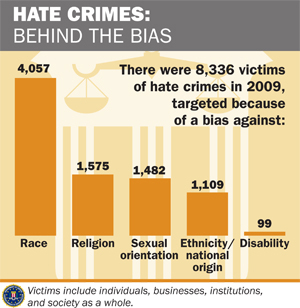| << Chapter < Page | Chapter >> Page > |
Not all crimes are given equal weight. Society generally socializes its members to view certain crimes as more severe than others. For example, most people would consider murdering someone to be far worse than stealing a wallet and would expect a murderer to be punished more severely than a thief. In modern American society, crimes are classified as one of two types based on their severity. Violent crimes (also known as “crimes against a person”) are based on the use of force or the threat of force. Rape, murder, and armed robbery fall under this category. Nonviolent crimes involve the destruction or theft of property, but do not use force or the threat of force. Because of this, they are also sometimes called “property crimes.” Larceny, car theft, and vandalism are all types of nonviolent crimes. If you use a crowbar to break into a car, you are committing a nonviolent crime; if you mug someone with the crowbar, you are committing a violent crime.
When we think of crime, we often picture street crime , or offenses committed by ordinary people against other people or organizations, usually in public spaces. An often overlooked category is corporate crime , or crime committed by white-collar workers in a business environment. Embezzlement, insider trading, and identity theft are all types of corporate crime. Although these types of offenses rarely receive the same amount of media coverage as street crimes, they can be far more damaging. The current economic recession in the United States is the ultimate result of a financial collapse triggered by corporate crime.
An often-debated third type of crime is victimless crime . These are called victimless because the perpetrator is not explicitly harming another person. As opposed to battery or theft, which clearly have a victim, a crime like drinking a beer at age 20 or selling a sexual act do not result in injury to anyone other than the individual who engages in them, although they are illegal. While some claim acts like these are victimless, others argue that they actually do harm society. Prostitution may foster abuse toward women by clients or pimps. Drug use may increase the likelihood of employee absences. Such debates highlight how the deviant and criminal nature of actions develops through ongoing public discussion.
On the evening of October 3, 2010, a 17-year-old boy from the Bronx was abducted by a group of young men from his neighborhood and taken to an abandoned row house. After being beaten, the boy admitted he was gay. His attackers seized his partner and beat him as well. Both victims were drugged, sodomized, and forced to burn one another with cigarettes. When questioned by police, the ringleader of the crime explained that the victims were gay and “looked like [they] liked it” (Wilson and Baker 2010).
Attacks based on a person’s race, religion, or other characteristics are known as hate crimes . Hate crimes in the United States evolved from the time of early European settlers and their violence toward Native Americans. Such crimes weren’t investigated until the early 1900s, when the Ku Klux Klan began to draw national attention for its activities against blacks and other groups. The term “hate crime,” however, didn’t become official until the1980s (Federal Bureau of Investigations 2011).
An average of 195,000 Americans fall victim to hate crimes each year, but fewer than five percent ever report the crime (FBI 2010). The majority of hate crimes are racially motivated, but many are based on religious (especially anti-Semitic) prejudice (FBI 2010). After incidents like the murder of Matthew Shepard in Wyoming in 1998 and the tragic suicide of Rutgers University student Tyler Clementi in 2010, there has been a growing awareness of hate crimes based on sexual orientation.


Notification Switch
Would you like to follow the 'Introduction to sociology' conversation and receive update notifications?